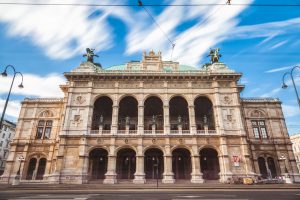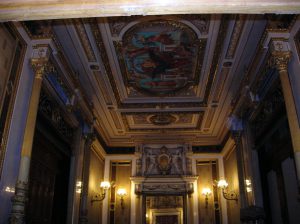The Vienna State Opera
By Tracy A. Burns
 When the Vienna State Opera opened in 1869 with a performance of Mozart’s Don Giovanni, the exterior of the building triggered harsh criticism because it was austere rather than romantic in style. The interior, though, earned high acclaim. On March 12, 1945, five bombs almost destroyed the building that had been on fire for 24 hours. Only 70 percent of the façade, the vestibule, the staircase, the foyer, and the tea room survived the raging flames. It would be another 10 years before the opera house was restored. Now, 22-carat gold leaf décor adorns the building along with allegorical statuary, breathtaking tapestries, stunning ceiling paintings, and astounding wall ornamentation.
When the Vienna State Opera opened in 1869 with a performance of Mozart’s Don Giovanni, the exterior of the building triggered harsh criticism because it was austere rather than romantic in style. The interior, though, earned high acclaim. On March 12, 1945, five bombs almost destroyed the building that had been on fire for 24 hours. Only 70 percent of the façade, the vestibule, the staircase, the foyer, and the tea room survived the raging flames. It would be another 10 years before the opera house was restored. Now, 22-carat gold leaf décor adorns the building along with allegorical statuary, breathtaking tapestries, stunning ceiling paintings, and astounding wall ornamentation.
The exterior
On the exterior, a loggia façade enthralls with statues of muses on horseback. A triumphal arch is set prominently in front of the main roof. Above it is a shield flanked by eagles with the Habsburg-Lorraine coat-of-arms, topped by the Austrian imperial crown. The glassed-in loggia boasts five bronze statues, such as Heroism and Fantasy, the tallest because it is the source of all arts. The water sprite Lorelei, whose beauty and song caused sailors to crash their vessels, is perched on top of a fountain on the front façade. Another statuary represents Love as a maiden with flower petals; Mourning who is in the midst of covering her face with one hand; and the wild-haired Revenge, armed with a dagger, ready for battle. Twenty coats-of-arms of states and provinces in the Austro-Hungarian Empire adorn the façade, too.
The main staircase
 The interior is even more fascinating. Consider the monumental main staircase, for instance. The main staircase shows off seven allegorical statues made of Carrara marble, representing arts such as music, dance, and sculpture. The painting on the ceiling, “Praise and Recognition,” depicts in vibrant colors a female figure gripping a roll of music and holding a trumpet and laurel wreath. Cherubs throw gold coins as if they were confetti. Grotesque birds stand out near the stairwell arcades.
The interior is even more fascinating. Consider the monumental main staircase, for instance. The main staircase shows off seven allegorical statues made of Carrara marble, representing arts such as music, dance, and sculpture. The painting on the ceiling, “Praise and Recognition,” depicts in vibrant colors a female figure gripping a roll of music and holding a trumpet and laurel wreath. Cherubs throw gold coins as if they were confetti. Grotesque birds stand out near the stairwell arcades.
The tea room
Emperor Franz Joseph used to sip tea here. Roped off from the public, the tea room can only be viewed from one side. Peeking into the space, visitors are sure to become enamored with the golden silk embroidered wall panels boasting the emperor’s monogram. Austrian coats-of-arms also make up the pattern. On the ceiling, the allegorical figure of Music, perched on an eagle and holding a lyre, ascends toward Heaven.
The Marble Hall
Marble from 13 countries in Europe was used to create the marble mosaics on the walls of this hall. The mosaics illustrate common backstage activities at the opera house. For example, in one panel a singer is trying on her costume. The theatre flies – the area above the stage from which scenery is suspended and lowered – are depicted, too. A dance rehearsal and choir rehearsal also are portrayed.
The foyer
The foyer shows off 14 busts of composers and lunettes depicting scenes from legendary operas, including The Magic Flute, The Marriage of Figaro, and Don Juan by Wolfgang Amadeus Mozart. Busts of Franz Schubert, Joseph Haydn, and Ludwig van Beethoven make appearances, too. The five busts of conductors include a likeness of Gustav Mahler, created by August Rodin. The Habsburg Monarchy is not absent from this room, either. Portrait medallions feature Empress Maria Theresa and Emperor Leopold I, who was also a composer and ruled for 47 years. Gold and floral décor provide ornamentation on the ceiling and walls.
The loggia and Gustav Mahler Hall
Frescoes from The Magic Flute decorate the loggia. Visitors see the protagonist Papageno, disguised as an elderly woman, meeting Papagena, and Papageno is saved by three boys after he tries to commit suicide. In the center of the middle loggia, Maria Theresa and a young Mozart are depicted in a mother and child fashion. The Gustav Mahler Hall, named after the opera’s director from 1897 to 1907, shows off 13 stunning tapestries from The Magic Flute.
The auditorium
The opera house has 1,709 seats plus 567 spaces for standing room. The crystal chandelier in the auditorium is overwhelming: It weighs 12 tons and measures 7 meters in diameter. The safety curtain is decorated with the mythological scene in which Orpheus and Eurydice bid farewell to the underworld.
The main stage and backstage areas
The stage, 27 meters high and 50 meters deep, is twice as large as the auditorium. The performance area features six platforms, and there is a revolving stage at the back of the main stage. A side stage provides quick scenery changes. There are 110 flies above the stage. The trap bridge has three trapdoors, and there are three-stage wagons. The trap bridge functions on a hydraulic and electrical system, and hydraulic power operates the machinery below and above the stage. The backstage area is 21 meters wide while the proscenium opening is 13 meters wide. Some 110 musicians can play in the orchestra pit, which is possible to lower on three platforms. About 120 stagehands and technicians work per night while the artistic staff numbers 500. Approximately, 1,000 people are employed by the opera, which offers performances 10 months per year. The company produces about 50 or 60 operas plus 10 ballet productions each year and gives approximately 300 performances annually.




